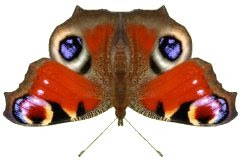I have seen several Peacock butterflies so far this year (along with rather more Brimstones and one Comma). They are always a delight to see, and they also offer food for thought – why such a spectacular, hyperreal simulation of four 'eyes'? Can it really be just a case of protective mimicry? Surely it goes way beyond any possible usefulness. And look what happens when you turn the Peacock upside down – suddenly it's an owl! This is surely not protective mimicry: apart from anything else, the butterfly's predators typically attack from behind rather than in front. Is a predator going to think, 'Aha, here's a nice juicy butterfly. I think I'll just take a look round the front and... Oh my Lord, it's not a butterfly – it's an owl! I'm off.'? Hardly likely.
As Nabokov wrote (in Speak, Memory) on the extraordinary exuberance of butterfly mimicry, 'nor could one appeal to the theory of "struggle for life" when a protective device was carried to the point of mimetic subtlety, exuberance, and luxury far in excess of a predator's power of appreciation. I discovered in nature the non-utilitarian delights that I sought in art. Both were a form of magic, both were a game of intricate enchantment and deception.'


Such things make one think that this is done just for us as we alone are capable of appreciating it fully. An argument from the aesthetic for the existence of God?
ReplyDeleteIndeed, this would have seemed the obvious conclusion to draw, before Darwin came along and spoiled everything.
ReplyDelete